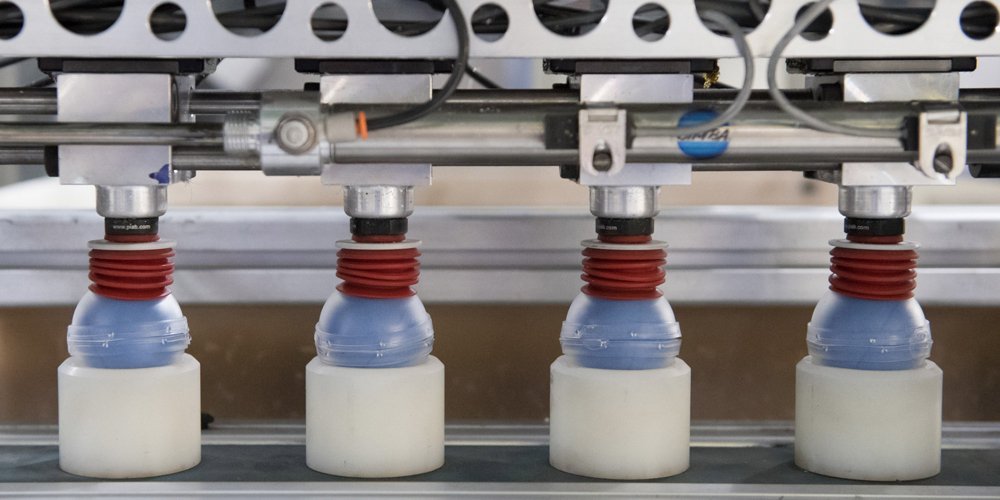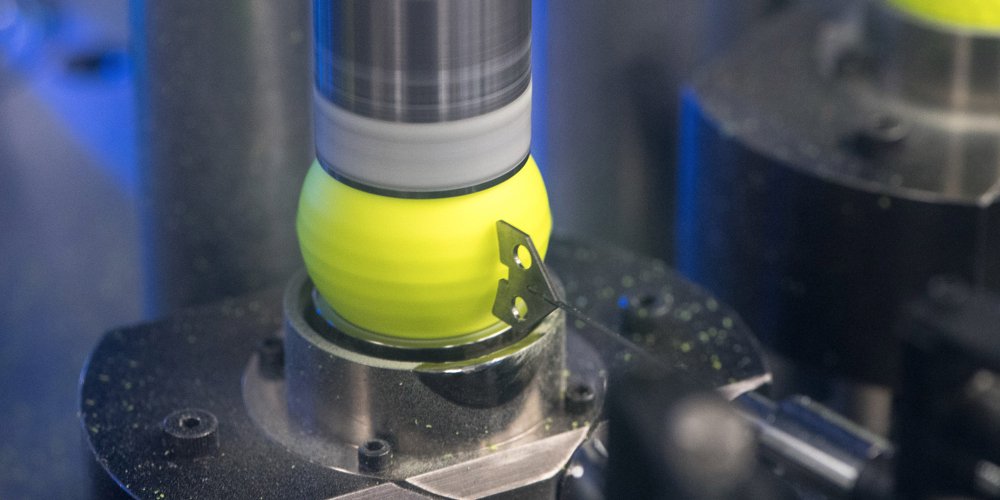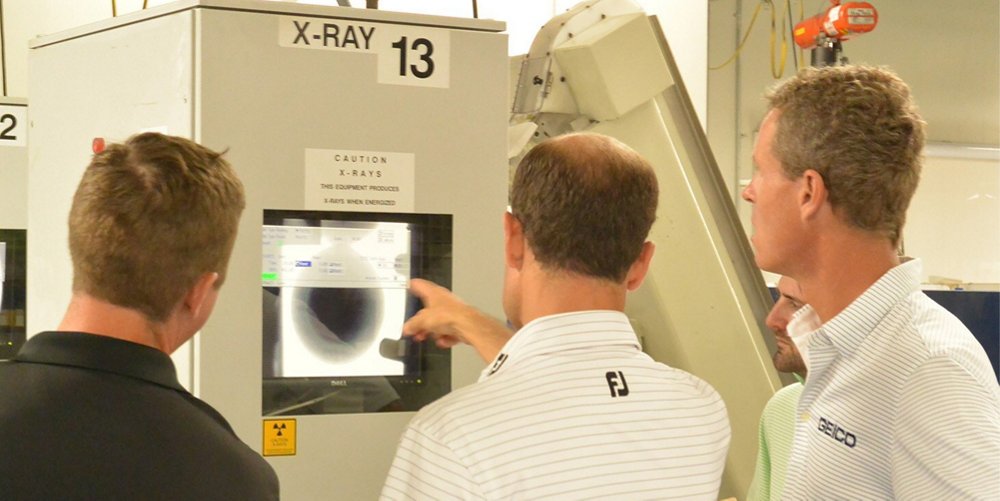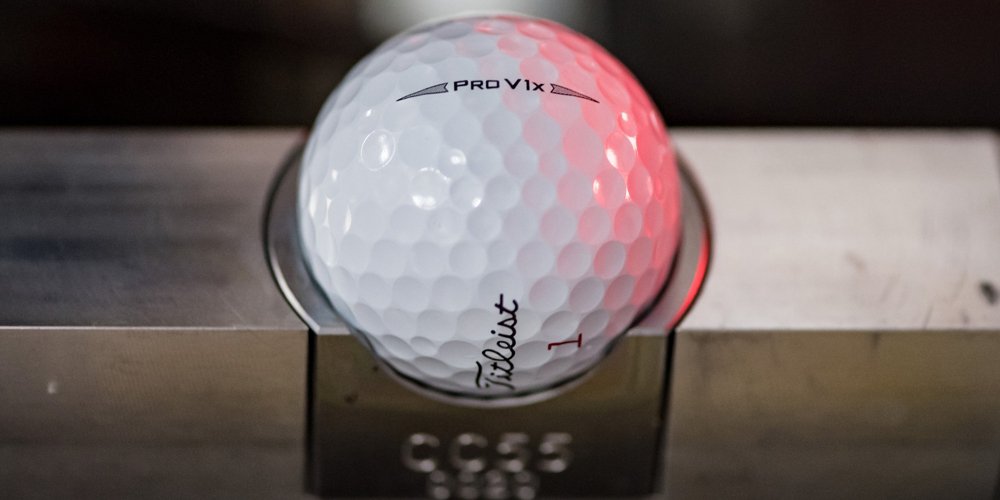In order to make a golf ball, you need some specialized equipment. You’ll also need some raw materials, including rubber, resin, and metal. The manufacturing process is actually quite complex, and there are several different steps that are involved in the production of a golf ball.
In this blog post, we’ll take a closer look at how golf balls are made. We’ll explain the technical details that go into their design, and we’ll provide a step-by-step process explaining how they are produced.
Table of Contents
How is a golf ball made?
A process called vulcanization is used to make golf balls. This process was invented by Charles Goodyear in the 19th century, and it involves the use of heat and pressure to create a cross-linking between molecules in a rubber compound. More details on Goodyear discovery here.
Some more recent patents(2008) on golf making have been approved. Some of the earliest patents approved date back some 100 years ago in 1908 when William Taylor’s invention was approved by the US Patents office.
The first step in vulcanization is to mix the rubber compound with sulfur. The sulfur helps to create the cross-linking between the molecules in the rubber. The rubber compound is then placed in a mold, and it is heated to a temperature of about 140 degrees Celsius.
Once the rubber compound has been heated, it is cooled and removed from the mold. The next step is to cover the rubber ball with a layer of resin. The resin helps to give the ball its smooth surface.
After the resin has been applied, the ball is then covered with a layer of metal. The metal helps to protect the ball from wear and tear. Finally, the ball is painted and then packaged for sale.
Materials used to make golf balls:
- Rubber: This is the main material that is used in the production of golf balls. It provides the ball with its bounce and elasticity.
- Resin: This material is used to bind the rubber together. It also helps to give the ball its shape.
- Metal: The metal is used in the production of the ball’s core. It also helps to add weight to the ball, which affects its flight.
Equipment needed to make golf balls
- Mold: This is used to give the ball its shape.
- Core former: This machine is used to create the ball’s core.Cutter: This machine is used to cut the ball into its final shape.
- Painter: This machine is used to add the final touches to the ball, including the dimples.
Golf Ball Manufacturing Process:
Step 1:
The first step in the manufacturing process is to create the ball’s core. This is done by using a machine called a core former. The metal is heated until it is molten, and then it is injected into the core former. This machine is specifically designed to create the spherical shape of the ball’s core.
Step 2:
Once the core has cooled, it is removed from the core former. The next step is to add the rubber. The rubber is melted and then injected into the mold.
Step 3:
The next step is to add a layer of resin to the ball. This resin helps to bond the rubber layers together, and it also provides additional durability.
Step 4:
Once the resin has been added, a layer of metal is applied. This metal layer helps to give the ball its spin.
Step 5:
The final step is to add a layer of paint. This is done for aesthetic purposes, and it also helps to protect the ball from damage.
After all of these steps have been completed, the golf ball is then ready to be used.
How golf balls are made by Titleist:
In February 2021, Titleist launched a virtual tour showcasing its manufacturing process.
In order to make a golf ball, you need some specialized equipment.
Titleist haa also shared their entire process on their website here.
10 Steps in the Process of Making Titleist Golf Balls
Below are all the processes/steps that Titleist takes when makings its golf balls;
- Core mixing
- Core molding
- Grinding
- Casing layer
- Urethane cover
- Removing the casts
- X-Raying
- Buffing
- Painting
- Hand checks
Core mixing:
The first step in Titleist’s manufacturing process is to mix the rubber and metal that will make up the ball’s core. This mixture is then placed into a mold where it will be formed into the ball’s core.

Core molding:
The next step is to mold the core mixture into the desired shape. Titleist uses a machine called a core former to do this. The metal is heated until it is molten, and then it is injected into the core former. This machine is specifically designed to create the spherical shape of the ball’s core.

Grinding:
Once the core has cooled, it is removed from the core former. The next step is to grind the ball. This helps to remove any imperfections and gives the ball its final shape.

Casing layer:
After the ball has been ground, a thin layer of rubber is applied. This rubber layer helps to protect the ball’s core from damage.

Urethane cover:
The next step is to add a layer of urethane. This urethane layer helps to give the ball its spin.
Removing the casts:
The next step is to remove the ball from its mold. This is done by using a machine called a cutter. The cutter cuts the ball into its final shape.
X-Raying:
After the ball has been cut, it is X-Rayed. This helps to ensure that the ball is free of defects.

Buffing:
The next step is to buff the ball. This helps to remove any imperfections and gives the ball a smooth finish.

Painting:
The final step is to add a layer of paint. This is done for aesthetic purposes, and it also helps to protect the ball from damage.

Hand checks:
After the ball has been painted, it is hand checked for quality. This ensures that each ball meets Titleist’s high standards.
Below is an image showing some of Titleist’s top-line performance golf balls;

Rules of Golf Standards on Golf Ball Design:
In order to be approved by the United States Golf Association (USGA) and therefore used in official competitions, a golf ball must meet certain standards. These standards are outlined in the Rules of Golf, and they include the following:
- The ball must not be larger than 1.68 inches in diameter.
- The ball must not weigh more than 1.62 ounces.
- The ball must have a uniform surface.
- The ball must not be designed to unduly influence the flight of the ball.
For golf ball manufacturers to obtain a conformance ruling, each type or model of ball must be tested and 24 samples collected. If the specimens meet the Equipment Rules, the model is added to The List of Conforming Golf Balls, which is updated monthly. The most up-to-date list may be found on The R&A’s and USGA’s websites. You may get more information from The R&A or USGA regarding how to submit your golf balls.
Section 4.2 in the Rule of Golf states that golf balls that meet the conditions must meet the Equipment Rules.

Part 4 of the Equipment Rule specifies(page 65 to 67) that golf balls must meet the following set standards:
| Categories of Golf Ball Evaluation by USGA | USGA Rules on Golf Ball Manufacturing Requirements |
|---|---|
| General | The ball must not be substantially different from the traditional and customary form and make. The material and construction of the ball must not be contrary to the purpose and intent of the Rules |
| Weight | The weight of the ball must not be greater than 1.620 ounces avoirdupois (45.93 g). |
| Spherical Symmetry | The ball must not be designed, manufactured or intentionally modified to have properties which differ from those of a spherically symmetrical ball. |
| Size | The diameter of the ball must not be less than 1.680 inches (42.67 mm). |
| Initial Velocity | The initial velocity of the ball must not exceed the limit specified under the conditions set forth in the Initial Velocity Standard for golf balls on file with The R&A and USGA. |
| Overall Distance Standard | The initial velocity of the ball must not exceed the limit specified under the conditions set forth in the Initial Velocity Standard for golf balls on file with The R&A and USGA. |
Below are the screenshots that I obtained from USGA’s Booklet on Equipment Rules;

These are just a few of the standards that a golf ball must meet in order to be approved for use in official competitions. There are many other rules and regulations that govern the design and manufacture of golf balls, so it is important to consult the USGA’s rules before designing or manufacturing a golf ball.
How Manufactured Golf Balls Are Tested
After a ball has been designed and manufactured, it must be tested to ensure that it meets the USGA’s standards. This testing is done by an independent laboratory, and it includes a number of different tests. Some of these tests include the following:
- Abrasion test: This test is done to ensure that the ball’s surface will not be damaged by friction.
- Compression test: This test is done to ensure that the ball’s core is of the proper hardness.
- Dimension test: This test is done to ensure that the ball’s dimensions are within the USGA’s guidelines.
Once a ball has passed all of these tests, it is then approved for use in official competitions.
Here is a list of all confirming Golf balls that meet USGA standards.
How many golf balls are made every year?
There are more than 80 different types of golf balls available on the market, each with its own unique construction and design. According to a 2017 publication, approximately 1.2 billion golf balls are produced every year. In terms of the number of golf balls produced daily and monthly, this translates to approximately 3.3 million golf balls being produced every day, and 100 million golf balls being produced every month. This number has likely increased in recent years, as the popularity of golf continues to grow around the world.
How many golf balls are lost every year, monthly, and daily?
Although it may seem like there are a lot of golf balls being manufactured, an estimated 300 million are discarded or are lost in the United States annually. The study by Danish Golf Union reiterated that golf balls have the potential to create a large environmental issue because they can take 100 to 1,000 years to decompose.
Monthly about 10 million golf balls are lost and 300,000 are lost daily.
In the United States, there are enough golf balls lost each year to fill more than 8,500 school buses. 300 million golf balls would also be enough to cover every square foot of New York City’s Central Park with nearly 9 inches of golf balls.
Steps to combat the environmental impact of golf ball manufacturing and other lasting impacts
Golf Ball Recycling Process
Golf balls can be recycled and used for a variety of purposes. For example, some companies use recycled golf balls to create other products, such as jewelry or key chains. Others use them for landscaping purposes, or to fill in divots on golf courses.
The recycling process begins by sorting the golf balls by their condition. This is typically done by hand, although some companies have developed machines that can sort the balls automatically. Once the balls are sorted, they are cleaned and then crushed into small pieces.
The crushing process breaks down the golf ball’s cover and inner core, which makes it easier to extract the material that can now be used in Making a new Golf Ball
Going Green – Manufacturing Sustainable Golf Balls:
Processes to create sustainable golf balls that are eco-friendly and biodegradable are still nascent with few studies exploring the topic. I found this 2018 Study from Canadian scholars exploring the use of soybeans to make sustainable golf balls.
In making the case for the brand called Max Sustainable Golf Balls, they found that their process costs around $0.75 for one ball’s raw ingredients, which is comparable to the average price of $2 per regular golf ball.
What this means to you as a beginner, pro, or senior golfer:
Beginners in particular will appreciate the fact that there are inexpensive and long-lasting golf balls available on the market. This is a blessing for individuals concerned about the environmental effects of discarded or lost golf balls. If you are in the market for golf balls for beginners, read our reviews here.
Jump on the sustainable golf ball brands as soon as they hit the market and as the technology for sustainable golf balls improves, the price is likely to go down, making them more affordable for everyone.
If you are a seasoned casual, pro or even senior golfer that has gotten used to playing with golf balls made from non-sustainable processes, you can still make a difference by making sure that the balls you already have are not randomly discarded.
You can also join the golf balls share economy, similar to the way carpools or ride-sharing reduces the amount of dirty fossil waste released into the air.
Overall, I encourage you to support any brand or company that leads the way in offering both recycled and eco-friendly options for customers.
You can also show your support by purchasing golf gear from companies that donate a portion of their proceeds to environmental causes. Callaway is one of them through the Callaway Foundation and through its sustainability efforts as captured in their Reports.
Aside from Callaway, which other companies make golf balls in the US?
4 Factories Making Golf Balls in the US:
90% of golf balls being retailed here in the US come from one of 4 factory towns located in only 3 states. These factories are;
TITLEIST – New Bedford, Mass.
No company in the world makes more balls of better quality than Titleist. Their 1,200 employees in its ball operations have a combined 23,000 years of experience making balls.
That’s a lot of years! R&D and all other manufacturing operations are centralized within a few mile radius of its central location in Bedford. Golf Digest wrote in this piece that Titleist’s R&D, production, testing, custom-logo, and distribution facilities are all located within an eight-mile radius.
Image credit: golfdigest.com
CALLAWAY – Chicopee, Mass.
Callaway has its golf ball manufacturing roots in Massachusetts, with a long lineage that includes the Top-Flite and Strata brands it acquired along the way. The company employs about 200 people at its Chicopee facility, which is where all of its golf balls are made. SRI Sports, which Callaway acquired in 2003, also has a facility in Chicopee that produces golf clubs.
BRIDGESTONE – Covington, Ga.
Image credit: bridgestonegolf.com
Bridgestone golf balls are made in Covington, Georgia, at a plant that the company says is the largest golf ball manufacturing facility in the world. Bridgestone’s golf ball business employs about 400 people, and the company has been making golf balls in Georgia since 1985.
TAYLORMADE – Liberty, S.C.
TaylorMade’s golf ball factory is located in Liberty, South Carolina. The company would not disclose how many people it employs at the facility, but said that it is the “largest and most technologically advanced golf ball plant in the world.” TaylorMade has been making golf balls since 1999.
Soft vs hard golf ball manufacturing:
To make a soft golf ball, you need to use a softer rubber. This type of ball is generally used by beginners, as it is easier to control. To make a hard golf ball, you need to use a harder rubber. This type of ball is generally used by more experienced players, as it provides more distance.
As defined by the USGA, a hard golf ball is compressible up to 90. To achieve this hardness, different molds are used as well as varying types of rubber.
What is compression and how does it affect the hardness of a golf ball?
Compression is a measure of how much they press a golf ball. The harder the ball, the less it will compress. The softer the ball, the more it will compress. The USGA has set the maximum compression for a golf ball at 90. This means that a golf ball can be up to 90% compressed and still be within the rules.
Read the difference between soft and hard golf balls and when to use each type.
Innovation and Progress in Golf Balls Manufacturing Technology:
Over the years, there have been many innovations in golf ball design and manufacturing. Some of the most notable include:
- Multilayer Balls: Most modern golf balls have multiple layers. The cover is typically made from a harder material, such as Surlyn, while the core is usually made from a softer material, such as rubber. This construction helps to minimize spin on the ball while still providing good feel and control.
- Dimple design: The dimples on a golf ball help to reduce drag and keep the ball in the air for longer periods of time. Dimples also help to create spin, which can be used to control the ball’s flight.
- Compression: Compression is a measure of how much the ball squashes when it is hit. A higher compression golf ball will compress less, resulting in less energy being transferred to the ball. This can lead to longer drives, but may also result in less feel and control.
These are just a few of the innovations that have been made in golf ball design and manufacturing. As technology continues to progress, we can expect even more advances in the future.
What’s Next for Golf Ball Manufacturing?
The future of golf ball manufacturing is likely to be driven by two main forces: environmental concerns and technological advancements. As more and more people become aware of the environmental impact of golf, manufacturers will be under pressure to produce balls that are more eco-friendly. This could mean using recycled materials or finding ways to reduce the amount of water and energy used in the manufacturing process.
On the technological front, we can expect to see continued progress in areas such as dimple design and compression. 3D printing is also likely to play a role in the future of golf ball manufacturing, as it has the potential to create balls with custom designs and specific characteristics.
As the game of golf evolves, so too will the technology and equipment used to play it. Golf ball manufacturers will need to stay on the cutting edge in order to keep up with the demands of the market.
Hi there! I am Justin, one of the founders here at Golf Bagsy. I have been golfing since I was 12 and have participated in over 50 tournaments since 2018. When COVID took over the golf tournament schedules during the lockdowns, I spent a good amount of time doing research and writing about golf. I also provide part-time coaching for those looking to learn how to play golf and can be reached at justin@golfbagsy.com.



